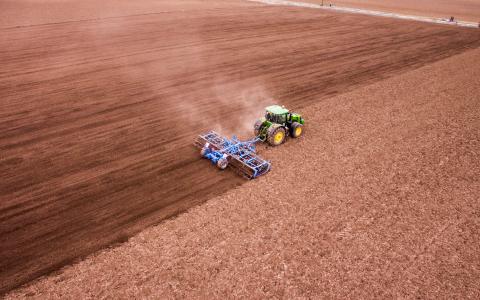
(MoneyWise) - The stock market is a scary place right now. The S&P 500 and Nasdaq are all deep in the red year to date. With raging inflation and an aggressive Fed, the outlook doesn’t seem particularly bright either.
Yet GAMCO Investors chairman and CEO Mario Gabelli still sees opportunities on the horizon — particularly in agriculture.
“We want to buy agricultural companies,” the billionaire investor tells CNBC. And for good reason. The agricultural industry receives billions of dollars in global subsidies every year.
In 2020, the Organisation for Economic Co-operation and Development found that governments worldwide provide an average of $536 billion per year of direct support to farmers.
Gabelli points to two names he likes in particular from the sector.
Deere (DE)
Commanding over $100 billion of market cap, Deere is one of the largest manufacturers of agricultural machinery and heavy equipment in America. So it’s no surprise that the stock is on Gabelli’s list.
“We like companies like Deere,” he says.
Despite supply chain pressures, Deere’s net sales rose 25% year over year in the quarter ended July 31. At the same time, the company earned a net income of $1.88 billion, or $6.16 per share, marking a substantial increase from the $1.67 billion, or $5.32 per share in the year-ago period.
The stock has also been resilient amid the broad market’s sell-off.
Year-to-date, Deere shares are up 5.5%, in stark contrast to the S&P 500’s double-digit percentage drop.
CNH Industrial (CNHI)
CNH Industrial is a British-American equipment and services company. While the company is not as big as Deere in terms of market cap, its Case and New Holland brands have built entrenched positions in the agriculture and construction machinery industry.
“We particularly like at the moment: Case New Holland,” Gabelli tells CNBC.
“There are 1.3 million shares, the stock is around $12. We think they can earn a buck and a half to $2, within 12 months.”
Indeed, the company has been growing its bottom line. In Q2, CNH Industrial’s adjusted diluted earnings per share came in at 43 cents, up from 37 cents earned in the same period last year.
Consolidated revenue totaled $6.08 billion for the quarter, representing a 17.5% increase year over year. This was driven by a 19% growth in net sales from the agriculture segment to $4.72 billion.
Still, CNH Industrial shares are down 25% so far in 2022. If you agree with Gabelli’s view, the company could be a contrarian opportunity.
More ways to invest in agriculture
Agriculture is a recession-resistant industry. Concerns about a global food shortage have already led to strong prices in agricultural commodities.
For a convenient way to get broad exposure to the sector, check out the Invesco DB Agriculture Fund (DBA). It tracks an index made up of futures contracts on some of the most widely traded agricultural commodities — including corn, soybeans, and sugar.
Investors can also use ETFs to tap into individual agricultural commodities. The Teucrium Wheat Fund (WEAT) and the Teucrium Corn Fund (CORN) have gained 20% and 28%, respectively, in 2022.
Last but certainly not least, you can consider investing in farmland itself. After all, Gabelli isn’t the only billionaire bullish on agriculture: Bill Gates now happens to be the largest private owner of farmland in the U.S.
It’s easy to see the appeal of this asset class: markets can go up or down, but no matter what happens, people still need to eat. That makes farmland intrinsically valuable.
Fine art as an investment
Stocks can be volatile, cryptos make big swings to either side, and even gold is not immune to the market’s ups and downs.
That’s why if you are looking for the ultimate hedge, it could be worthwhile to check out a real, but overlooked asset: fine art.
Contemporary artwork has outperformed the S&P 500 by a commanding 174% over the past 25 years, according to the Citi Global Art Market chart.
And it’s becoming a popular way to diversify because it’s a real physical asset with little correlation to the stock market.
On a scale of -1 to +1, with 0 representing no link at all, Citi found the correlation between contemporary art and the S&P 500 was just 0.12 during the past 25 years.
Earlier this year, Bank of America investment chief Michael Harnett singled out artwork as a sharp way to outperform over the next decade — due largely to the asset’s track record as an inflation hedge.
Investing in art by the likes of Banksy and Andy Warhol used to be an option only for the ultrarich. But with a new investing platform, you can invest in iconic artworks just like Jeff Bezos and Bill Gates do.
By Jing Pan
September 16, 2022
Jing is an investment reporter for MoneyWise. Prior to joining the team, he was a research analyst and editor at one of the leading financial publishing companies in North America. An avid advocate of investing for passive income, he wrote a monthly dividend stock newsletter for the better half of the past decade. Jing holds a Master’s Degree in Economics and an Honours Bachelor of Science Degree, both from the University of Toronto.



